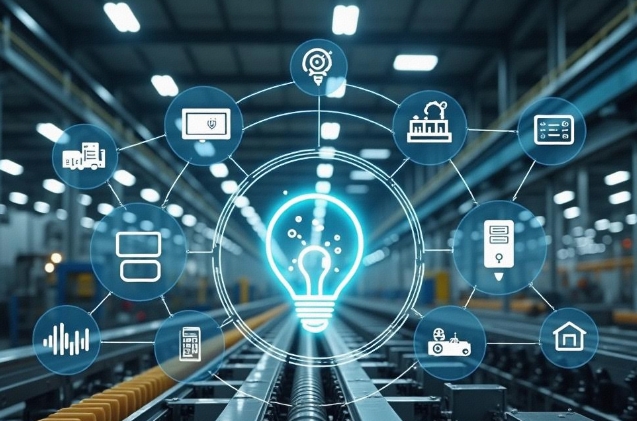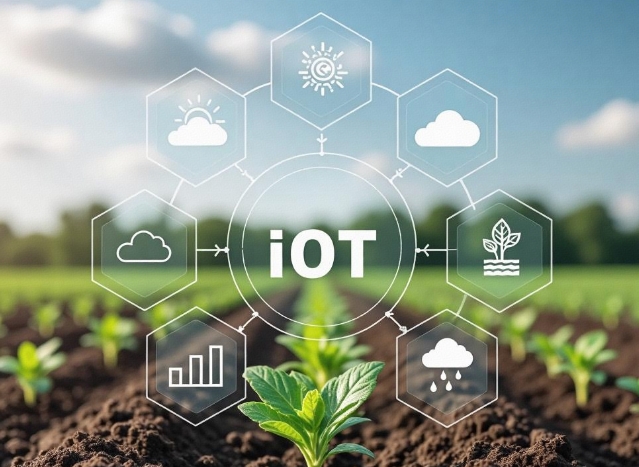Digital Transformation and Industry Applications in IoT Development
- latest articles
- 1.DApp Development & Customization: Merging Diverse Market Needs with User Experience 2.Analysis of the Core Technical System in DApp Project Development 3.How to achieve cross-chain interoperability in Web3 projects? 4.How does the tokenization of points reconstruct the e-commerce ecosystem? 5.How to Set and Track Data Metrics for a Points Mall? 6.What is DApp Development? Core Concepts and Technical Analysis 7.Inventory of commonly used Web3 development tools and usage tips 8.Development of a Distribution System Integrated with Social E-commerce 9.Six Key Steps for Businesses to Build a Points Mall System 10.What is DApp Development? A Comprehensive Guide from Concept to Implementation
- Popular Articles
- 1.Future Trends and Technology Predictions for APP Development in 2025 2.Analysis of the DeFi Ecosystem: How Developers Can Participate in Decentralized Finance Innovation 3.From Zero to One: How PI Mall Revolutionizes the Traditional E-commerce Model 4.DAPP Development | Best Practices for Professional Customization and Rapid Launch 5.How to Develop a Successful Douyin Mini Program: Technical Architecture and Best Practices 6.Recommended by the Web3 developer community: the most noteworthy forums and resources 7.From Cloud Computing to Computing Power Leasing: Building a Flexible and Scalable Computing Resource Platform 8.Shared Bike System APP: The Convenient Choice in the Era of Smart Travel 9.How to Create a Successful Dating App: From Needs Analysis to User Experience Design 10.From Design to Development: The Complete Process of Bringing an APP Idea to Life
With the continuous advancement of technology and evolving societal needs, the Internet of Things (IoT) as an emerging technology has had a profound impact globally. It not only changes our way of life but also deeply drives the digital transformation across various industries. IoT development represents not only a technological trend of the era but also symbolizes the inevitable path for traditional industries toward intelligence and automation. In this article, we will delve into how IoT development drives digital transformation and analyze its applications across different sectors.
I. Definition and Development History of IoT
The Internet of Things refers to connecting various information-sensing devices to the network via the internet to achieve information collection, transmission, processing, and feedback. An IoT system typically consists of a perception layer, a network layer, and an application layer. The perception layer collects data through various sensors and hardware devices, the network layer is responsible for data transmission and processing, and the application layer makes decisions and takes actions based on the processed results.
The origin of IoT can be traced back to the 1990s, when internet technology was gradually maturing, but interconnectivity between devices still faced significant challenges. With continuous advancements in sensor technology, wireless communication technology, embedded systems, and other fields, IoT gradually evolved from a concept to reality. Today, IoT has expanded into areas such as smart homes, intelligent transportation, smart cities, and industrial automation, becoming a key driver of digital transformation.
II. Digital Transformation Through IoT Development
The core value of IoT lies in promoting digital transformation across industries through the digital perception and control of the physical world. Digital transformation refers to the comprehensive reform of business processes, organizational structures, and operational models by enterprises or organizations using digital technologies to improve efficiency, reduce costs, and enhance competitiveness. The widespread application of IoT provides strong support for digital transformation, specifically in the following aspects:
1. Data-Driven Decision Making
By connecting numerous devices and sensors, IoT generates massive amounts of data. This data can not only be used to analyze current business conditions but also provide valuable insights for future decision-making. Through in-depth analysis of IoT data, enterprises can achieve precise market forecasting, product innovation, and customer demand prediction, thereby enhancing the scientific accuracy of decisions. For example, in the retail industry, IoT can monitor inventory in real-time, predict product demand based on consumer purchasing behavior, reduce overstocking, and optimize supply chain management.
2. Enhancing Production Efficiency
In traditional production processes, many steps rely on manual operations, which often suffer from inefficiency and high error rates. The application of IoT technology enables real-time monitoring and automated control of production processes, thereby improving efficiency. For instance, in smart manufacturing, IoT connects various machinery and equipment to collect real-time production data, analyze bottlenecks in the process, and optimize adjustments through intelligent means, significantly enhancing production line efficiency.
3. Transforming Customer Experience
IoT also plays a crucial role in enhancing customer experience. Through IoT technology, businesses can capture real-time customer needs, behavior patterns, and preferences, enabling them to offer personalized products and services. For example, in smart homes, by connecting various smart devices, users can remotely control home appliances, adjust temperature, lighting, and other parameters via voice assistants or mobile apps, greatly improving comfort and convenience.
4. Promoting Green Development
IoT helps enterprises better monitor and manage energy consumption, achieving green production and sustainable development. In the energy sector, IoT technology can monitor the usage of electricity, water, natural gas, and other resources in real-time, helping optimize energy management, reduce waste, and lower carbon emissions through data analysis. In agriculture, IoT enables precision farming by monitoring soil moisture, climate conditions, and other factors, optimizing the use of water and fertilizers, and enhancing both efficiency and environmental sustainability in agricultural production.
III. Applications of IoT in Various Industries
IoT applications span nearly every industry. Below are some typical use cases across different sectors.
1. Smart Manufacturing
Smart manufacturing is one of the earliest and most widely adopted fields for IoT technology. Through IoT, manufacturing enterprises can achieve interconnectivity across production equipment, assembly lines, warehouse management, and supply chains. Sensors on equipment collect real-time production data, the network layer transmits this data, and the application layer utilizes big data analytics and machine learning to assist managers in making intelligent decisions. For example, in the automotive manufacturing industry, IoT technology enables real-time tracking of each vehicle on the production line, accurately recording progress and quality issues at every stage, thereby achieving full visibility and automation of the production process.
2. Smart Cities
Smart cities represent a major application scenario for IoT technology. Through IoT, various urban infrastructures such as transportation, energy, environmental monitoring, and public safety can be managed intelligently. Intelligent transportation systems can monitor traffic flow and road conditions in real-time via traffic sensors, optimizing traffic signal control to alleviate congestion; environmental monitoring systems can detect air quality, water pollution, etc., providing early warnings for environmental hazards. The development of smart cities not only improves the efficiency of urban management but also enhances the quality of life for residents.
3. Healthcare
In the healthcare industry, IoT technology improves the efficiency and precision of medical services through remote monitoring, smart devices, and data analysis. IoT devices such as smart blood pressure monitors and heart rate sensors can track patients' health conditions in real-time and transmit data to hospital systems, allowing doctors to diagnose and adjust treatment plans based on live data. Additionally, IoT promotes the development of personalized medicine by analyzing patients' historical and real-time data, enabling doctors to create more precise treatment plans.
4. Smart Agriculture
IoT technology is also widely applied in agriculture, particularly in precision farming and intelligent agricultural management. By deploying sensors to monitor environmental factors such as soil moisture, temperature, and light, farmers can gain real-time insights into crop growth and perform irrigation, fertilization, and other operations as needed. IoT technology helps farmers increase production efficiency, reduce resource waste, and achieve sustainable agricultural practices.
5. Smart Logistics
IoT technology is extensively used in the logistics industry as well. Through IoT, logistics companies can achieve end-to-end tracking and monitoring of goods, obtaining real-time information on location, temperature, humidity, and more. This not only improves logistics efficiency but also helps prevent damage or loss during transit. In cold chain logistics, the combination of temperature sensors and GPS tracking ensures that perishable goods remain within the optimal temperature range throughout transportation, maintaining product freshness and safety.
IV. Challenges and Prospects in IoT Development
Despite the broad application prospects of IoT technology across industries, its development and implementation still face several challenges. First, the security of IoT devices remains a critical issue. Due to the vast number and wide distribution of IoT devices, ensuring security across devices is difficult, making them potential targets for cyberattacks. Second, standardization in IoT is not yet fully resolved, leading to poor interoperability of data across devices and platforms, which poses obstacles to its application. Additionally, data privacy is a significant challenge in IoT development; protecting user privacy and preventing data breaches are urgent issues that need to be addressed.
Nevertheless, with ongoing technological advancements, the future of IoT remains promising. The integration of emerging technologies such as 5G, artificial intelligence, and edge computing will bring higher efficiency, stronger processing capabilities, and broader application scenarios to IoT. In the coming years, IoT is expected to further drive digital transformation across industries, becoming a key driver of economic and social development.
Conclusion
As a crucial technology driving digital transformation, the widespread application of IoT is profoundly changing operational models across various industries. From smart manufacturing to smart cities, from precision medicine to smart agriculture, IoT applications are reshaping how we live and work. Although challenges exist, with technological progress and policy support, the future of IoT is undoubtedly full of limitless possibilities. Industries should actively embrace IoT technology, promote digital transformation, and seize opportunities for future development.
-

How to Use IoT Development to Enhance Supply Chain Efficiency
With the rapid development of the global economy and the deepening of digital tr···
-

Development and Innovation of the Internet of Things in the Healthcare Sector
With the rapid advancement of information technology, the Internet of Things (Io···
-

Data Storage and Analysis Methods in IoT Development
The Internet of Things (IoT) is one of the most revolutionary innovations in tod···

 Blockchain
Blockchain












